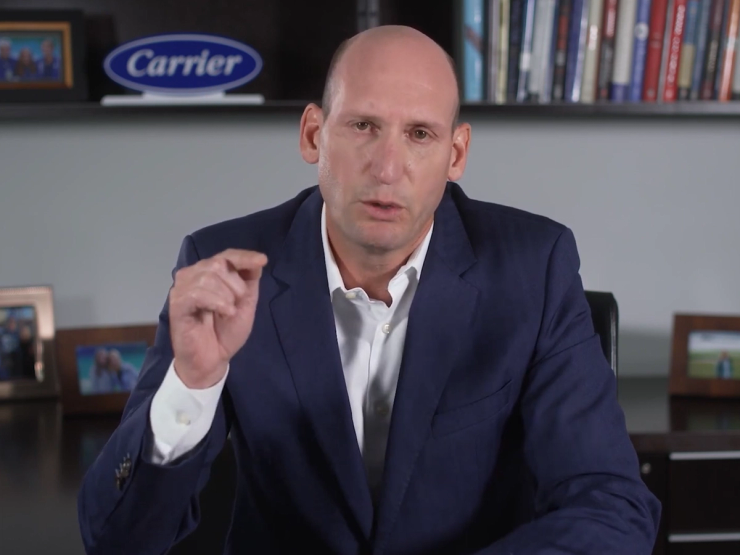The Scene
When Boeing’s directors were hunting last year for a new chief executive to turn around the accident-prone plane maker, one name on the short list was sitting with them. David Gitlin, the Chairman and CEO of Carrier Global, had more than two decades of aerospace industry experience. As importantly, his turnaround of the US air conditioning and refrigeration group had earned him a reputation as one of the most effective industrial executives in a country that has seen too many Boeing-like stories of manufacturing titans gone adrift.
“I was flattered to be considered,” Gitlin says of the Boeing job, which ultimately went to Kelly Ortberg, the former CEO of Collins Aerospace. But Gitlin adds that he withdrew his name because he thought Carrier was “in the midst of doing something that history will prove is very, very special.”
Carrier’s compensation committee agreed, telling shareholders it was “critical” to retain Gitlin with an enhanced incentive package that made him the sixth-highest-paid US CEO last year, with a package of $65.7 million. The directors pointed to his striking record of shareholder value creation since he led Carrier’s separation from its former parent, United Technologies, in April 2020. Between then and the end of last year, Carrier recorded total shareholder returns of 330%. That beat not only the S&P 500 index, but also Apple, Microsoft, and most of the market’s other best performers.
In this article:
The Signal Interview
Early wins and an internal overhaul
Carrier had strong positions in key markets, but its growth had been uneven, and Gitlin thought it had lacked investment. The dismantling of United Technologies, which also gave elevator maker Otis Worldwide its independence and led to the creation of RTX, happened in the chaotic early weeks of the COVID-19 pandemic, handing him another challenge.
Gitlin assured investors that his “100-year-old startup” would be more focused and agile as it pursued growth from new products and stronger service and digital offerings. But “people didn’t know whether we were serious, so we had to put a bunch of wins on the board.”
Some of those wins were obvious externally. Carrier raised an unexpected $10 billion from shedding four businesses while striking acquisitions, including the $13 billion purchase of Viessmann Climate Solutions, to strengthen its position in its most attractive markets. Other moves required a less visible internal overhaul at the 50,000-person company.
“There is a certain comfort that can come from bureaucracy and process,” but it conflicts with accountability, Gitlin says. “What we wanted was a system where every individual feels accountable to the objectives of Carrier.”
That meant removing layers of management and simplifying processes for things like designing new products and taking on new customers. “We had to really push pace,” he says, so instead of five reviews before approving a major customer, there’s now one.
He also spent eight months crafting the Carrier Way, a one-page statement of the company’s vision, values, and culture that emphasizes speed, innovation, and winning. It’s not all “kumbaya,” Gitlin says: Rethinking Carrier’s culture also meant changing half of its top 200 executives in the first two years after its listing.
“At first, there were a lot of people that did not like the accountability,” he explains. He soon replaced them with people he prized for their drive, sense of mission, and ability to energize their teams.
‘It starts with reality’
Gitlin spent more than 20 years with United Technologies, in roles including president of UTC Aerospace Systems, before being put in charge of Carrier in 2019. But, asked what his old employer’s culture was, he says he doesn’t think it had one. In a conglomerate, he notes, people can always blame another division if earnings fall short. “It was just such diffused accountability, it was hard to listen to an earnings call and think that you somehow affected the stock price.”
One of the biggest benefits of Carrier’s independence, Gitlin believes, has been that its people now know they matter to its performance. He tells every executive to listen to its earnings calls, to drive home the point that they’re responsible for its returns to shareholders.
Three things have been most important to Carrier’s transformation, he says: changing people, establishing a new culture, and launching “goal alignment”. Like GE’s Larry Culp — of whom he says “you’d be hard pressed to find a better CEO in the country” — Gitlin is a student of the Toyota Production System. He has borrowed the carmaker’s model of defining clear targets and cascading the key performance indicators by which progress will be measured down to every employee. Now, he says, “all 50,000 people know how their KPIs affect the priorities of the company.”
Getting such details right was part of Gitlin’s bigger goal of changing the way people think about Carrier. He wants his company to be seen not as a manufacturer of air conditioners, but as “a global leader in intelligent climate and energy solutions.”
“We have a long way to go,” he says, “but I think it starts with reality.”
Staying agile to catch the tailwinds
Last month, he laid out the details of the next chapter of his plan for Carrier, pitching it as a more focused company with a stronger performance culture, delivering outsize growth by solving customers’ problems. Carrier can find 6% to 8% organic sales growth and mid-teens growth in adjusted earnings per share each year over the medium term, he told shareholders.
It has two strong tailwinds propelling it forward. First, the data centers that support a booming artificial intelligence industry need cooling — one that Carrier worked on last year required 140 chillers, in contrast to the three that he estimates regulate the temperature in a typical office building.
Second, a warming planet is driving demand for more air conditioning. Buildings’ heating and cooling systems already account for an estimated 15% of global carbon emissions, even though only 10% of the 3.5 billion people living in the world’s hottest places have air conditioning. How Carrier meets that demand without further heating the planet is “a very good question,” Gitlin admits. “We know that our industry is part of the problem. So we know that we have to be part of the solution,” he says, adding that its investments in more sustainable technologies are paying off because customers want more energy-efficient offerings.
Carrier faces headwinds, too. It is a big user of steel and aluminum, imports of which the Trump administration imposed 50% tariffs on this week. So far, it has fully mitigated the impact through supply chain and productivity actions, coupled with $300 million worth of price increases.
“It’s really hard to argue with wanting free and fair trade, and there’s always different means to an end and different strategies to get there,” Gitlin says diplomatically of US trade policies, “but the sooner that gets solidified and clarified, the better.”
Grit, low ego, and a pie chart of priorities
The pandemic, supply chain crunches, and the geopolitical upheavals of the past five years have taught Gitlin to value people who can deliver results even in such plan-busting circumstances. He tries to hire “low-ego” people with the “grit and resilience to persevere without excuses.”
The restocking of his direct reports is behind him, but Gitlin still allocates time for interviewing senior job candidates each week, as part of a schedule that he has aligned rigorously with his own performance targets. Carrier’s annual review of its long-term strategy leads to its annual financial plan, which feeds into its “goal alignment” process, he explains. That informs the targets the board sets for him, which in turn frame how he allocates his hours spent with interviewees, shop floor employees, customers and other stakeholders. “What I try to do is be very purposeful through a pie chart of how I spend my time,” he says.
It’s an approach that has been shaped by “so many mistakes” and experiences, Gitlin says. But the period in his career that influenced his leadership style most was more than 15 years ago, when United Technologies moved him from its Connecticut headquarters to an auxiliary power unit business in Southern California.
The team there was full of “people I’d go to war with any day of the week,” but they felt deflated after years of underinvestment. “They knew what it took to change the operations, but they weren’t given the latitude to make those changes,” Gitlin recalls. His task was to ask: “What can I do to help you, and how can I protect you from others that are trying to not let you be as great as you are?”
What the experience taught him, he says, was “the power of a team just coming together to try to do great things for its customers and achieve results on its own — without any excuses.”
Correction
A previous version of this story incorrectly stated the company formerly led by Kelly Ortberg. It was Collins Aerospace, not RTX.


